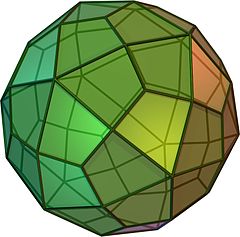| Deltoidal hexecontahedron | |
|---|---|
 (Click here for rotating model) | |
| Type | Catalan |
| Conway notation | oD or deD |
| Coxeter diagram | |
| Face polygon |  kite |
| Faces | 60 |
| Edges | 120 |
| Vertices | 62 = 12 + 20 + 30 |
| Face configuration | V3.4.5.4 |
| Symmetry group | Ih, H3, [5,3], (*532) |
| Rotation group | I, [5,3]+, (532) |
| Dihedral angle | 154.1214° arccos(-19-8√5/41) |
| Properties | convex, face-transitive |
 rhombicosidodecahedron (dual polyhedron) |
 Net |

In geometry, a deltoidal hexecontahedron (also sometimes called a trapezoidal hexecontahedron, a strombic hexecontahedron, or a tetragonal hexacontahedron[1]) is a Catalan solid which is the dual polyhedron of the rhombicosidodecahedron, an Archimedean solid. It is one of six Catalan solids to not have a Hamiltonian path among its vertices.[2]
It is topologically identical to the nonconvex rhombic hexecontahedron.
- ^ Conway, Symmetries of things, p.284-286
- ^ "Archimedean Dual Graph".